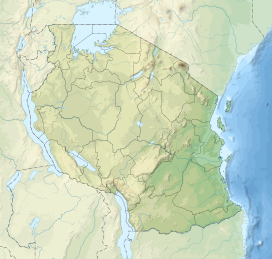| Mount Kilimanjaro | |
|---|---|
 Kilimanjaro from Amboseli National Park, Kenya | |
| Highest point | |
| Elevation | 5,895 m (19,341 ft) |
| Prominence | 5,895 m (19,341 ft) Ranked 4th |
| Isolation | 5,510 km (3,420 mi) |
| Coordinates | 03°04′33″S 37°21′12″E / 3.07583°S 37.35333°E |
| Geography | |
| Location | Kilimanjaro Region, Tanzania |
| Parent range | The Eastern Rift mountains |
| Topo map(s) | Kilimanjaro map and guide by Wielochowski[2] |
| Geology | |
| Rock age | 4 million years |
| Mountain type | Stratovolcano |
| Last eruption | Between 150,000 and 200,000 years ago |
| Climbing | |
| First ascent | 6 October 1889 by Hans Meyer and Ludwig Purtscheller |
Mount Kilimanjaro (/ˌkɪlɪmənˈdʒɑːroʊ/)[3] is a dormant volcano in Tanzania. It is the highest mountain in Africa and the highest free-standing mountain above sea level in the world: 5,895 m (19,341 ft) above sea level and 4,900 m (16,100 ft) above its plateau base. It is also the highest volcano in the Eastern Hemisphere and the fourth most topographically prominent peak on Earth.
Kilimanjaro's southern and eastern slopes served as the home of the Chagga Kingdoms until their abolition in 1963 by Julius Nyerere. The origin and meaning of the name Kilimanjaro is unknown, but may mean "mountain of greatness" or "unclimbable". Although described in classical sources, Germany missionary Johannes Rebmann is credited as the first European to report the mountain's existence, in 1848. After several European attempts, Hans Meyer reached Kilimanjaro's highest summit in 1889.
The mountain was incorporated into Kilimanjaro National Park in 1973. As one of the Seven Summits, Kilimanjaro is a major hiking and climbing destination. There are seven established routes to Uhuru Peak, the mountain's highest point. Although not as technically challenging as similar mountains, the prominence of Kilimanjaro poses a serious risk of altitude sickness.
One of several mountains arising from the East African Rift, Kilimanjaro was formed from volcanic activity over 2 million years ago. Its slopes host montane forests and cloud forests. Multiple species are endemic to Mount Kilimanjaro, including the giant groundsel Dendrosenecio kilimanjari. The mountain possesses a large ice cap and the largest glaciers in Africa, including Credner Glacier, Furtwängler Glacier, and the Rebmann Glacier. This ice cap is rapidly shrinking, with over 80% lost in the 20th century. The cap is projected to disappear entirely by the mid-21st century.
- ^ Cite error: The named reference
XPATS Internationalwas invoked but never defined (see the help page). - ^ Kilimanjaro Map and tourist Guide (Map) (4th ed.). 1:75,000 with 1:20,000 and 1:30,000 insets. EWP Map Guides. Cartography by EWP. EWP. 2009. ISBN 0-906227-66-6. Archived from the original on 17 July 2015.
- ^ "Kilimanjaro, Mount". Oxford Dictionaries UK English Dictionary. Oxford University Press. Archived from the original on 16 July 2015. "Kilimanjaro, Mount". Lexico. Archived from the original on 9 July 2015. Retrieved 25 August 2014.


